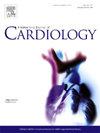阻塞性肥厚型心肌病切除术后的术前 D-二聚体和预后。
IF 3.2
2区 医学
Q2 CARDIAC & CARDIOVASCULAR SYSTEMS
引用次数: 0
摘要
背景:D-二聚体对接受房间隔切除术的肥厚型心肌病患者的预后意义尚未确定:D-二聚体对接受房间隔切除术的肥厚型心肌病患者的预后意义尚未明确:我们回顾性分析了 2009 年至 2018 年期间在我院接受房间隔切除术的 728 例患者的 D-二聚体水平。我们将基线 D-二聚体水平分为三等分(结果:D-二聚体水平越高,与室间隔切除术相关性越大:较高的D-二聚体水平与年龄较大、性别为女性、较严重的二尖瓣反流以及N末端前B型钠尿肽水平升高(P 0.29 mg/L)有关,这些因素显著增加了全因死亡风险(危险比[HR],3.12;95 % 置信区间[CI],1.42-6.86;P = 0.005)和心血管死亡风险(HR,3.29;95 % CI,1.12-9.62;P = 0.030)。体重指数和左心房直径也是全因死亡率(分别为 HR,1.12;p = 0.026 和 HR,1.08;p = 0.006)和心血管死亡率(分别为 HR,1.12;p = 0.043 和 HR,1.11;p = 0.004)的独立预测因子。将D-二聚体水平大于0.29 mg/L纳入其中可提高全因死亡率的净再分类指数(p = 0.016):结论:D-二聚体是室间隔切除术患者中长期全因死亡率和心血管死亡率的可靠预测指标。本文章由计算机程序翻译,如有差异,请以英文原文为准。
Preoperative D-dimer and outcomes in obstructive hypertrophic cardiomyopathy after myectomy
Background
The prognostic significance of D-dimer in patients with hypertrophic cardiomyopathy undergoing septal myectomy has not been well established.
Methods
We retrospectively analyzed D-dimer levels in 728 patients who underwent septal myectomy at our hospital between 2009 and 2018. Baseline D-dimer levels were categorized into tertiles (<0.21, 0.21–0.3, ≥0.3 mg/L) The primary and secondary endpoints were all-cause mortality and cardiovascular mortality, respectively. Cox regression and competing risk models were used to evaluate risk factors for all-cause and cardiovascular mortality, respectively.
Results
Higher D-dimer levels were associated with older age, female sex, more severe mitral regurgitation, and elevated N-terminal pro B-type natriuretic peptide levels (P < 0.05). Over a median follow-up of 4.2 years, 31 (4.3 %) patients reached the primary endpoint; 23 deaths were attributed to cardiovascular causes. The optimal cutoff D-dimer level for predicting 5-year mortality was 0.29 mg/L. After adjusting for covariates, D-dimer levels of >0.29 mg/L were significantly associated with an increased risk of all-cause mortality (hazard ratio [HR], 3.12; 95 % confidence interval [CI], 1.42–6.86; p = 0.005) and cardiovascular mortality (HR, 3.29; 95 % CI, 1.12–9.62; p = 0.030). Body mass index and left atrial diameter were also independent predictors of both all-cause mortality (HR, 1.12; p = 0.026, and HR, 1.08; p = 0.006, respectively) and cardiovascular mortality (HR, 1.12; p = 0.043, and HR, 1.11; p = 0.004, respectively). The inclusion of D-dimer levels of >0.29 mg/L improved the net reclassification index for all-cause mortality (p = 0.016).
Conclusion
D-dimer is a robust predictor of mid-to-long-term all-cause and cardiovascular mortality in patients undergoing septal myectomy.
求助全文
通过发布文献求助,成功后即可免费获取论文全文。
去求助
来源期刊

International journal of cardiology
医学-心血管系统
CiteScore
6.80
自引率
5.70%
发文量
758
审稿时长
44 days
期刊介绍:
The International Journal of Cardiology is devoted to cardiology in the broadest sense. Both basic research and clinical papers can be submitted. The journal serves the interest of both practicing clinicians and researchers.
In addition to original papers, we are launching a range of new manuscript types, including Consensus and Position Papers, Systematic Reviews, Meta-analyses, and Short communications. Case reports are no longer acceptable. Controversial techniques, issues on health policy and social medicine are discussed and serve as useful tools for encouraging debate.
 求助内容:
求助内容: 应助结果提醒方式:
应助结果提醒方式:


